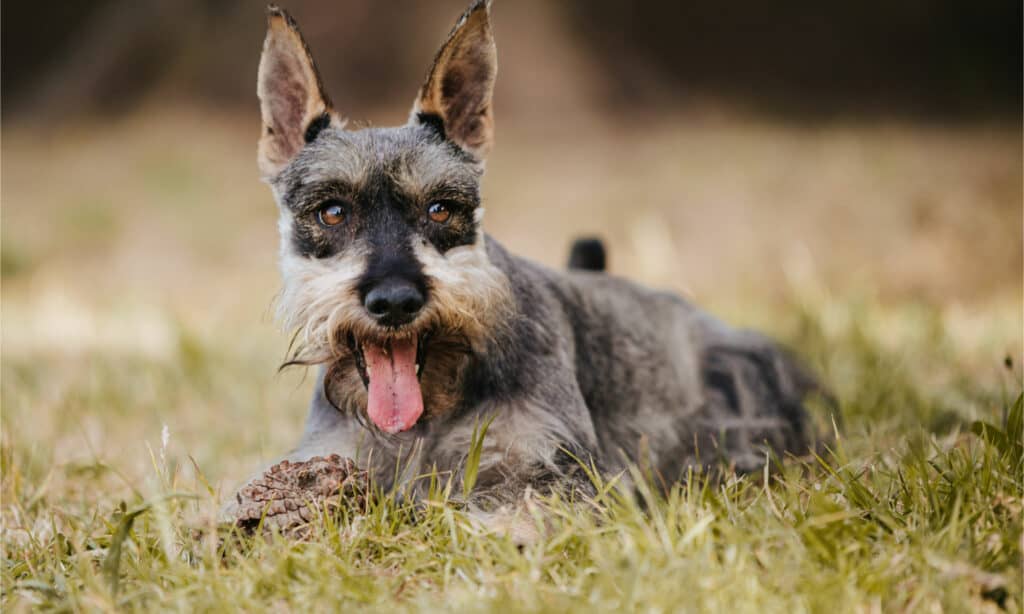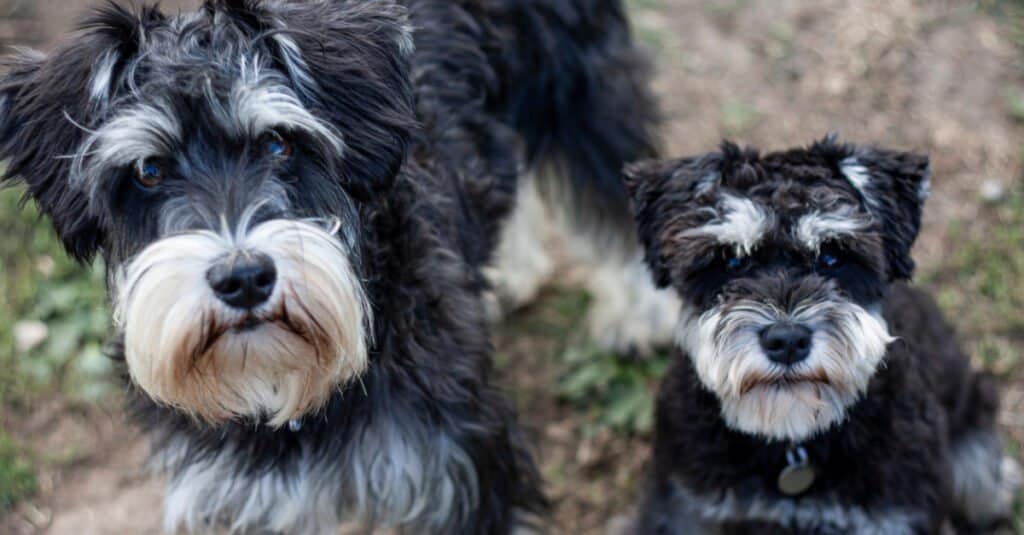Generally speaking, everyone loves dogs. However, the biggest question for every dog lover ever is what dog breed suits them best. If you are considering a Schnauzer breed, you may be torn between a Standard Schnauzer and a Miniature Schnauzer. Both are cute and are ideal as pets. In fact, they may often be seen on dog shows and are smart and easy to train. So, how can one choose between a Standard Schnauzer vs a Miniature Schnauzer? What are their differences? Below, we will delve into their unique features to help us make a choice.
Comparing a Miniature Schnauzer and a Standard Schnauzer

| Miniature Schnauzer | Standard Schnauzer | |
|---|---|---|
| Size | – height (12 to 14 inches) – weight (11 to 20 lbs) | – height (17 to 20 inches) – weight (30 to 50 lbs) |
| Adaptability | – very affectionate – good for young children – average openness level with strangers and other dogs | – adapts well to apartment living – good for novice owners- tolerates average climate |
| Lifespan | – 12 to 15 years | – lives 13 to 16 years |
| Trainability | – eager to please – average energy level – requires constant reward-based training | – alert – high energy level – ready to learn obedience lessons |
| Health and Grooming Needs | – average shedding level and high coat grooming frequency – high mental stimulation needs | – requires grooming daily- higher tendency to chew |
The 5 Key Differences of Standard Schnauzer and Miniature Schnauzer
The main differences between a Standard Schnauzer and Miniature Schnauzer are their size, adaptability, lifespan, trainability, and health and grooming needs. Schnauzer breeds are a great choice for owners with different lifestyles. Whether living in the city, countryside, in a small apartment, or a large house, one cannot go wrong in adopting these dogs considering their characteristics and traits. In this article, we will talk about five unique features in order to differentiate a Standard Schnauzer and a Miniature Schnauzer.
Standard Schnauzer vs Miniature Schnauzer: Size

The smallest schnauzer breed is the Miniature Schnauzer.
©Oakland Images/Shutterstock.com
Miniature Schnauzer is the smallest schnauzer breed. This schnauzer breed is only around 12 to 14 inches in terms of height as opposed to the Standard Schnauzer which is between 17 to 20 inches. The Standard Schnauzer males are 35 to 50 pounds heavy, while the females weigh 30 to 45 pounds. The females of the Miniature Schnauzer breed weigh 11 to 15 pounds, while the males are between 13 to 20 pounds. Due to their portable size, Miniature Schnauzers are always in the list of top 20 most popular breeds in the United States, England, and in Europe, particularly in Germany.
Standard Schnauzer vs. Miniature Schnauzer: Adaptability
Standard Schnauzers are good for novice owners, while Miniature Schnauzers are good for young children. Given their size and very affectionate nature, Miniature Schnauzers are better recommended as a young child’s best friend than Standard Schnauzers. Their outgoing personality and good looks make them fit for this role. They are also not as aggressive as other schnauzer breeds in spite of their tough, muscular, and protective nature. Although they are known to be extroverted and require a great deal of attention, they can tolerate being alone. On the other hand, a Standard Schnauzer’s ability to adapt in places with average temperatures, whether hot or cold, makes it more suitable for novice owners and those who live in apartments.
Standard Schnauzer vs. Miniature Schnauzer: Lifespan

Living up to 16 years, Standard Schnauzers live longer than Miniature Schnauzers.
©motiwaves/Shutterstock.com
Standard Schnauzers have a longer lifespan than Miniature Schnauzers. The average lifespan of a Standard Schnauzer and Miniature Schnauzer may be close, but the former can live between 13 to 16 years while the latter can only live up to 12 to 15 years. Both of these dog breeds originated in old-time Germany. But the Miniature Schnauzers are simply derived from small Standard Schnauzer mixed with Poodles, Affenpinschers, Pomeranians, or Miniature Pinscher and usually have no British blood. They used to take on the tasks of a fearless barnyard ratter but those days are over and they are now best suited as the lovable companions that they are. In comparison, Standard Schnauzers are good as search and rescue dogs.
Standard Schnauzer vs Miniature Schnauzer: Trainability
Standard Schnauzers have higher energy levels than Miniature Schnauzers. While the two schnauzer breeds make good watchdogs, Standard Schnauzers have higher energy and a strong-willed and high-spirited nature. Nonetheless, if one is looking for a smaller four-legged companion, the Miniature Schnauzer will be a better pick. The key is to have the confidence as an owner to take charge and consistently allow the dog to learn with plenty of reward-based training. They are also good in agility competitions. Still, the Standard Schnauzers are more alert and ready to learn obedience lessons. Just throw in varied activities and have them exercise often and they are good.
Standard Schnauzer vs. Miniature Schnauzer: Health and Grooming Needs
The Standard Schnauzers require more grooming than Miniature Schnauzers. Both the Standard Schnauzer and Miniature Schnauzer are healthy dog breeds in general. However, the Standard Schnauzer has a high tendency to chew, while the Miniature Schnauzer may be more prone to several health issues like cataracts, urinary stones, pancreatitis, and hyperlipidemia. Therefore, owners must keep tabs on their overall health condition. These dog breeds’ nails, paws, and ears must not go unchecked for a long time. Dental care must also be a priority. Of course, suffice to say, regular visits to the vet are important for both breeds or for any dog breed for that matter.
In terms of coating, the Standard Schnauzer’s coat is hard and straight. It is usually in pepper and salt or pure black color with facial hair that makes it seem like it has a beard. It also has a mustache and bristly eyebrows. Miniature Schnauzers, on the other hand, have a double coat. The topcoat is wiry while the undercoat is soft. While the Standard Schnauzer requires daily grooming, the Miniature Schnauzer requires bathing once a month or depending on their surroundings. Tripping and clipping their coat may be done every five to eight weeks.
Where Did Schnauzers Come From?

The Giant Schnauzer is one of three types, the other two being the standard schnauzer and miniature schnauzer.
©Bohemianroots, Public domain, via Wikimedia Commons – License
While our article looked at two types of schnauzers, there are a total of 3 types of schnauzers: miniature, standard, and giant. They all originated in Germany as farm dogs. The oldest type is the standard, considered to be the original schnauzer breed, dating back to the Middle Ages. Standard schnauzers were used for ratting, herding, guarding, and hunting. They are believed to be a mix of European herding and guard dogs with traces of grey wolfspitz and black poodles, which gave them their salt and pepper coloring.
Giant schnauzers likely resulted from crossing standards with Great Danes, Bouvier des Flandres, and sheepdogs. They were used to assist farmers in herding cattle, pulling carts, protecting livestock, and doing guard work. Meanwhile, miniature schnauzers were developed around 1899 by mixing standard schnauzers with affenpinschers and poodles. They were bred more for being show dogs and as house pets.
The photo featured at the top of this post is © cynoclub/Shutterstock.com
Ready to discover the top 10 cutest dog breeds in the entire world?
How about the fastest dogs, the largest dogs and those that are -- quite frankly -- just the kindest dogs on the planet? Each day, AZ Animals sends out lists just like this to our thousands of email subscribers. And the best part? It's FREE. Join today by entering your email below.
Thank you for reading! Have some feedback for us? Contact the AZ Animals editorial team.






